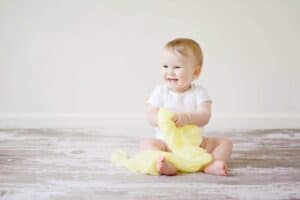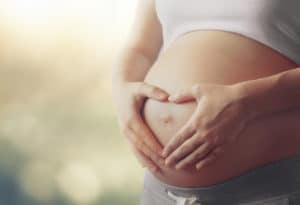Table of contents
Teething Baby – The Most Important Questions Answered In Advance
For new parents, the first baby year is an exciting, turbulent, and educational time full of challenges. When your baby shows signs of teething, you as a mother and father will inevitably be faced with the following questions: What helps with teething? Which teething aid is suitable for my baby? And do preparations such as teething gel or globules really help with teething? In order to accompany your child through this important development process as painlessly as possible, it is helpful to know the best tips and tricks to make teething as pleasant as possible for your baby. In addition, this article will tell you everything you need to know about teeth, babies, and teething aids.
Your Baby And His First Tooth – Baby Teething Cannot Be Planned
Baby teething cannot be planned. Strictly speaking, a newborn baby is born with twenty milk teeth, which, however, remain densely packed in the jaw until they erupt. Permanent teeth, which only become visible between the ages of 6 and 12, are also anchored in the jaw before birth. However, you can usually expect your baby’s first tooth to appear between the 6th and 7th months of life. In individual cases, early precursors for the so-called eruption of teeth in the baby also occur much earlier between the 3rd and 4th months. But even if the development of the milk teeth and thus the first signs of teething are delayed by a few weeks or months, there is no reason to worry.
Everything About Teething – When Your Baby’s First Teeth Appear
As a rule, your baby’s first teeth begin to erupt before his or her first birthday. What are a natural process and an important step forward in terms of healthy child development is, unfortunately, an extremely painful affair for almost every child. When the first teeth make their way through the baby’s still quite a soft jaw, your child is often plagued by unpleasant pain that manifests itself in typical symptoms ranging from crying to being cranky to fever. Find out which other signs you can recognize when your baby is teething and alleviate them with the right tips and aids.
When The First Teeth Appear – Your Baby And His First Tooth
Your baby and his first tooth: Once the first little tooth has erupted, another tooth is added every month on average. Usually, the teething process begins in the lower jaw with the lower front incisors. This is followed by the two upper incisors and, shortly thereafter, their two immediate neighbors. Around your baby’s first birthday, all eight incisors are visible. Six months later, the two front molars follow, and finally, the canines erupt through the jaw. The rear molars finish off and at around two to three years of age, your toddler’s milk dentition is complete with a total of twenty milk teeth.
Teething In Babies – What Helps With Teething?
So much for the theory. But how can you reliably tell that your baby is teething and what helps with teething? Before the first teeth visibly grow out of the jaw, the teething process has already begun in your child. In the months during tooth eruption, the jawbone begins to tighten and the gums swell. In addition, where a new tooth is trying to break through, a small white spot will show. As the baby teeth make their needed space, this process causes understandable pain, the gums itch, and your baby feels an uncomfortable sensation of pressure in the jaw. As this development naturally hurts, you often experience your baby as particularly restless and querulous during this time. In this case, it helps to pay more attention to your child and to let him or she forget the pain with games and activities. You can find valuable tips on this in our blog article“Spending time with the kids – great ideas for the whole year“. Especially at night, however, when there is no distraction from external stimuli, the pain is felt more strongly than during the day. It is difficult to fall asleep and stay asleep, your child wakes up more often than usual at night and cries. Caring and loving care by parents is especially important at this time.
Your Baby Starts Teething – Signs And Symptoms
Since the pain impulse is not felt equally strongly by all children, there are other signs besides crying that your baby is teething. Sometimes your child’s cheeks are noticeably red during this time and there is increased salivation. In some cases, the frequent drooling causes a mild rash around the baby’s mouth area. The skin on the bottom may also be slightly irritated, and it may also appear red and sore. Since the immune system is weakened by teething, colds including a cold and a febrile infection may occur more frequently than usual. However, if the fever persists over a longer period of time, a visit to a pediatrician is recommended, since teething is not necessarily the trigger in every case. The increased salivation stimulates intestinal activity, which often causes diarrhea and could be a further indication that your baby is struggling with the adversities of teething. However, if diarrhea persists for more than a day, please consult your pediatrician, as it is important to clarify the circumstances of watery stools, especially in the first months of life.
How You Can Tell That Your Baby Is Teething:
- Your baby is restless and crotchety, cries more often than usual.
- The jawbone is tense, the gums are swollen and itchy.
- There is a small white bulge on the jaw surface.
- Your baby’s cheeks are reddened, show a slight rash.
- There is increased salivation.
- The skin on the bottom is irritated and sore.
- Your baby has a feverish infection with a cold.
- There may be watery diarrhea.
- When the baby’s teeth grow – the right teething aid.
As soon as your baby senses that its first teeth are coming in, it will start to become active on its own. This includes, for example, trying more than ever to put all tangible objects in the mouth in order to relieve the pressure and pain in the jaw by biting on them. Chewing on solid objects helps to make the pain more bearable and has a beneficial effect on the eruption of milk teeth. Therefore, support your baby in this self-chosen first aid measure and provide your child with safe chewing aids. To avoid having to use your little fingers as a substitute for teething, we recommend a sufficiently large piece of sturdy bread or a thick raw carrot to start with. Your baby can hold these aids independently and use them as a soothing chewing aid. Chewing around on a slightly chilled baby spoon or damp washcloth can also help with teething pain. However, please keep a close eye on your child when giving him a chewing aid so that he does not accidentally put the spoon too deeply into his mouth or choke if something breaks off.
Baby Teething – Proven Teething Aids
Teething Baby – Teething Rings As A Proven Teething Aid
Teething rings are a proven and safe alternative to washcloths and the like and have always proved their worth as pain relief during teething. When buying a teething ring, look for a material composition that is harmless to health and free of plasticizers, so-called phthalates. Made of flexible plastic, the rings are available in different designs and can be stored in the refrigerator until they are needed. The special liquid inside the flexible ring has a cooling effect and brings your baby quick relief by chewing on the plastic ring. For more details on suitable teething rings, see our“Checklist: Toys up to 12 months“. Whether you opt for a chewing ring from the baby supply store or choose a household baby spoon as a teething aid – the following applies to all chilled items: Please only put them in the refrigerator and never in the freezer, as the chewing aids are otherwise too cold for the sensitive baby mouths.
Your Baby And His First Tooth – Gum Massage As A Benefit For Teething Babies
But what else helps with teething? Where a cooled teething ring won’t do the trick and a firm carrot won’t help against the itching, a gum massage performed by the parents can work wonders. Through sensitive massaging, you can feel exactly where in the oral cavity you can optimally respond to your baby’s current needs based on your child’s immediate reaction. Wash your hands thoroughly before massaging and massage your child’s gums either with your bare finger or use a special finger-ring. Made of silicone, these thimbles have a fine nubby texture and are specifically designed for baby’s oral and dental care, and are commercially available. In addition to the gum massage, unsweetened chamomile or sage tea helps in many cases. The disinfecting natural substances soothe irritated gums and can either be applied directly to the painful area with a cotton swab or given to the baby to drink.
Teeth And Baby – Medical Teething Gel As A Pain-relieving Teething Aid
If your baby is suffering too much from teething pain and natural aids do not provide any relief, your pediatrician will be happy to advise you on suitable remedies. For example, a medical teething gel can be prescribed as a teething aid, which is applied to the painful gums using an applicator or finger before feeding or breastfeeding. The cooling teething gel from the pharmacy ensures that the affected area is lightly numbed, providing your baby with relief from lasting pain. For application, however, it is worth mentioning that such teething gel only works when a little tooth is about to break through. Due to the low dosage of the anesthetic active ingredient, such a teething gel helps with the local teething pain but has no helping influence on the pressure in the jawbone.
Homeopathic Teething Aid – Do Globules Help With Teething?
If you as a parent prefer alternative remedies to medical anesthetic gel and the like, you may prefer to rely on homeopathic preparations for your child’s teething problems. Available as globules, drops or suppositories, these remedies are administered orally or rectally, depending on the intended use, and promise rapid pain relief. But do globules really help with teething? With the help of homeopathic mixed preparations, you can try to alleviate your baby’s pain in a natural way and thus use globules to help with teething. Over-the-counter remedies include preparations such as Escatitona drops, Osanit globules or Viburcol suppositories. If you have any questions regarding the appropriate globules for teething, consult a qualified homeopath in advance or use the comprehensive consultation service at your pharmacy.
Your Baby And The First Tooth – Do Dental Chains Help With Baby Teething?
Many midwives and mothers swear by the additional use of amber teething necklaces at the first signs of teething, but what does this really help with teething? As a traditional aid, an amber necklace is said to have a calming effect on the baby during the stressful teething period. Known as a gemstone, the fossil resin is placed around the baby’s neck in the form of a necklace and is said to help relax and calm the baby. However, among experts, the administration of an amber necklace during baby teething is controversial due to safety concerns. If you decide to use an amber necklace, it is therefore important to pay attention to some factors regarding the safety of your child: For example, the cord of the chain should be extremely tear-resistant and stable and should only break when a force of at least 90 newtons is applied, which corresponds to a weight of around 90 kilograms. This value is necessary so that your baby cannot tear the chain and run the risk of putting the stones in its mouth. In addition, each stone must be knotted individually, so that in case of tearing only one stone comes loose. For additional safety, high-quality chains have a predetermined breaking point such as a magnetic clasp, at which the chain can be easily opened with just one pull. This is to prevent babies from getting tangled in the chain or accidentally deflating. If you are unsure about an amber necklace for teething pain relief, your pediatrician will be happy to advise you.
First Teeth And Their Care – Brushing Baby’s Teeth Properly
The time has finally come: After a grueling time, your baby’s first milk teeth have arrived and now, of course, they want to be properly cared for. To promote healthy oral hygiene and prevent tooth decay from an early age, practice daily tooth brushing together with your child. For the first tooth, it is sufficient to clean it with a special finger toothbrush from the pharmacy in the morning and in the evening and to give your baby a pleasant gum massage. From the second tooth at the latest, it’s your child’s turn: with a small children’s toothbrush with a short head and very soft plastic bristles, your child can learn to brush his teeth regularly under your guidance. Once all the milk teeth are in place, it’s time for a brush with slightly longer bristles and a narrow head, so that your toddler can reach all the places in the mouth optimally. A mini blob of fluoride-containing children’s toothpaste is recommended by pediatricians from the very first tooth. To prevent accidental swallowing, spread the toothpaste evenly on your child’s toothbrush and set a good example yourself. To make it easier for your offspring to brush their teeth, it is a good idea to make a nice ritual out of the evening routine. Demonstrate to your baby with little games that brushing teeth can be fun, make him laugh, and show him that mom and dad also like brushing teeth. Read more: “Proper oral hygiene even before the first tooth“.












